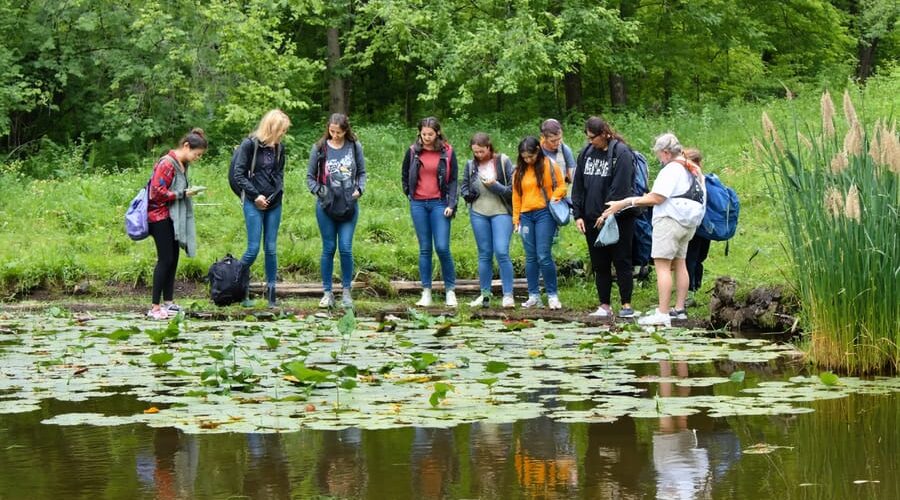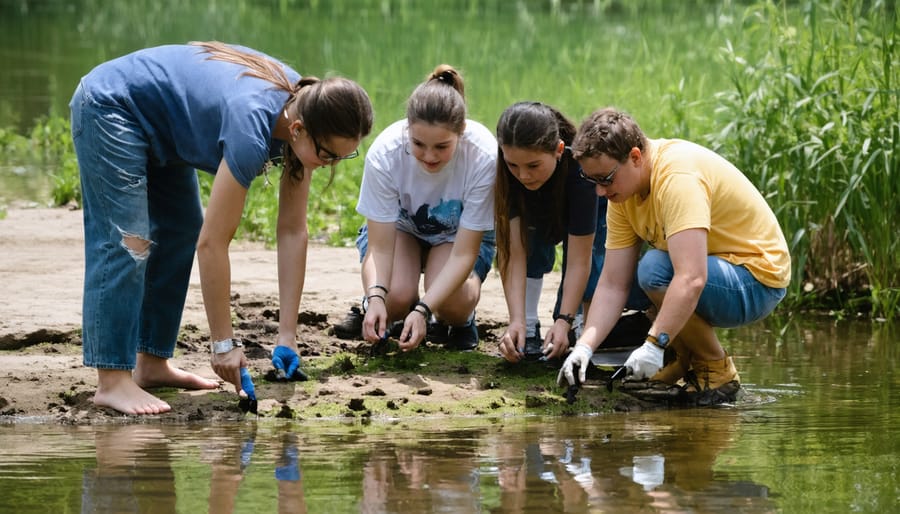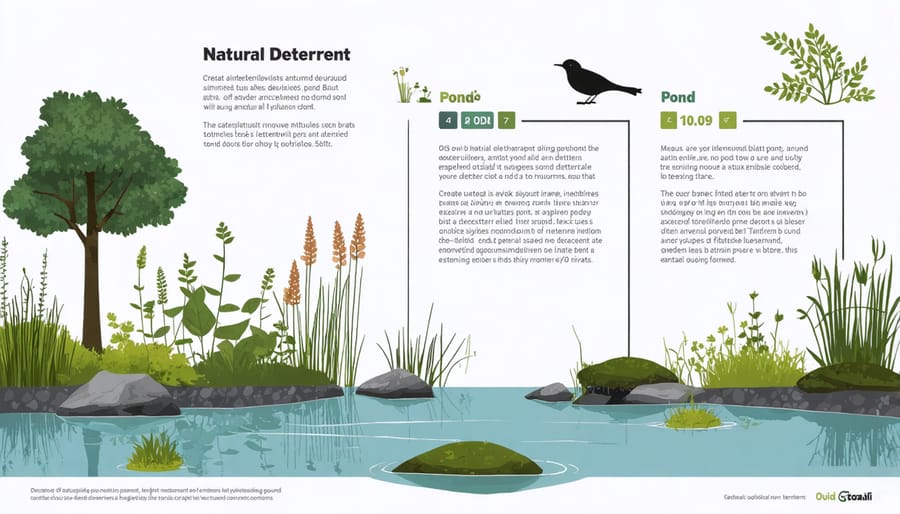
How Local Communities Are Revolutionizing Pond Predator Control
Community-engaged research transforms pond management from an isolated challenge into a collaborative success story. By partnering with local residents, environmental groups, and wildlife experts to manage pond predators effectively, pond owners create sustainable solutions that benefit entire ecosystems.
This research approach combines scientific methodology with local knowledge, creating a powerful framework for understanding and addressing water feature challenges. Community members contribute valuable observations about wildlife patterns, while researchers provide technical expertise and data analysis. Together, they develop practical strategies that respect both environmental needs and human interests.
The real strength of community-engaged research lies in its ability to build lasting partnerships. When neighbors work together to monitor pond health, share maintenance responsibilities, and implement protective measures, they create a network of informed caretakers who can respond quickly to emerging issues. This collaborative approach not only improves pond management outcomes but also strengthens community bonds and environmental stewardship.
Through shared learning and collective action, community-engaged research elevates simple pond maintenance into a meaningful connection between people and their local environment.
Why Community Engagement Matters in Pond Predator Management
Building Shared Knowledge
Community-engaged research thrives on the powerful combination of local wisdom and scientific expertise. When community members share their firsthand experiences and observations about local pond ecosystems, researchers gain invaluable insights that might otherwise be overlooked in traditional studies. For instance, longtime residents often possess detailed knowledge about seasonal wildlife patterns, historical changes in water levels, and successful traditional management practices.
Scientists contribute their systematic research methods, technical analysis capabilities, and broader theoretical understanding to this knowledge exchange. This partnership creates a more complete picture of local environmental challenges and potential solutions. Local pond owners might notice changing predator behaviors, while researchers can help identify specific species and suggest evidence-based deterrent strategies.
The collaboration often leads to innovative solutions that neither group could develop alone. For example, when community members share their successful DIY predator deterrents, researchers can study these methods scientifically, validate their effectiveness, and suggest improvements. This shared knowledge approach ensures that management strategies are both practically feasible and scientifically sound, while respecting local contexts and community needs.

Sustainable Long-term Solutions
Community-engaged research creates lasting solutions by fostering a sense of ownership and shared responsibility among participants. When local residents actively participate in pond management decisions and implementation, they develop a deeper understanding of ecological challenges and become long-term stewards of their water resources.
This collaborative approach leads to solutions that are better adapted to local conditions and more likely to be maintained over time. For example, when community members help design predator deterrent systems, they’re more likely to monitor and maintain them regularly. Their local knowledge often reveals practical insights that outside experts might miss, such as seasonal wildlife patterns or neighborhood-specific challenges.
Additionally, engaged communities tend to share their knowledge with newcomers, creating a self-sustaining cycle of education and involvement. This natural knowledge transfer ensures that successful practices continue even as community membership changes. The relationships built during these projects often spark other environmental initiatives, creating a ripple effect of positive change throughout the neighborhood.
By documenting successful community-driven solutions, these approaches can also serve as models for other communities facing similar challenges, multiplying their positive impact far beyond the original project scope.
Successful Community-Based Predator Management Strategies
Collaborative Monitoring Systems
Community-based monitoring systems have proven incredibly effective in tracking and managing pond predator activity. By working together, pond owners and community members create a network of vigilant observers who share information and resources. This collaborative approach not only improves predator detection but also strengthens community bonds.
Many successful monitoring programs start with a simple communication system, like a neighborhood group chat or social media page, where members can quickly report predator sightings. These platforms allow for real-time alerts when herons, raccoons, or other unwanted visitors are spotted in the area, giving nearby pond owners time to activate their deterrent systems.
Some communities have taken this further by creating detailed tracking maps and schedules. Volunteers take turns monitoring different areas during peak predator activity times, usually dawn and dusk. They record observations in shared logbooks or digital apps, building a valuable database of predator patterns and behaviors.
Training sessions help community members identify different predator signs, from footprints to disturbed vegetation. Regular meetings allow participants to share experiences and strategies, turning individual challenges into collective learning opportunities. Many groups also partner with local wildlife experts who can provide guidance on ethical deterrent methods and species identification.
This shared responsibility approach has shown that when communities work together, they can better protect their ponds while fostering a deeper appreciation for local wildlife and ecosystem management.
Natural Deterrent Methods
Community members have discovered that working together to implement predator-prey balance strategies can effectively protect local ponds while maintaining ecological harmony. By pooling resources and knowledge, neighborhoods have successfully developed natural deterrent solutions that respect both wildlife and human interests.
Popular community-driven approaches include planting barrier vegetation around pond perimeters, which not only deters unwanted visitors but also enhances the landscape’s natural beauty. Local gardening groups often organize native plant exchanges, sharing species that naturally repel common predators while attracting beneficial insects and birds.
Another successful strategy involves creating designated wildlife corridors and alternative water sources away from main ponds. This collaborative approach helps redirect predators to more suitable areas while maintaining the local ecosystem’s balance. Communities have also found success in implementing floating plants and protective netting systems, managed through shared maintenance schedules.
Education plays a crucial role, with neighborhood workshops teaching residents about beneficial predator species and their role in maintaining healthy pond ecosystems. These sessions often lead to coordinated efforts in installing motion-activated sprinklers and environmentally friendly deterrent lights, shared among multiple properties for maximum effectiveness.

Education and Training Programs
Education and training programs are vital components of community-engaged research, creating a two-way street of learning between researchers and community members. Local workshops serve as vibrant hubs where community members share their lived experiences while researchers contribute scientific expertise. These interactive sessions often feature hands-on activities, group discussions, and practical demonstrations that make complex concepts accessible to everyone.
Community members frequently take on roles as citizen scientists, learning to collect data, document observations, and use basic research tools. This hands-on involvement not only builds valuable skills but also helps participants understand the scientific process from the inside out. Training programs might include teaching community members how to conduct surveys, use monitoring equipment, or maintain detailed records of local environmental changes.
Knowledge-sharing events like community forums and neighborhood meetings provide platforms for residents to voice concerns, share traditional knowledge, and collaborate on research priorities. These gatherings often reveal valuable insights that might otherwise be overlooked in conventional research approaches.
Digital platforms and social media groups extend learning beyond physical meetings, creating ongoing spaces for resource sharing and discussion. Many communities develop their own training materials, translating scientific concepts into locally relevant examples and familiar language. This approach ensures that knowledge remains accessible and continues to circulate within the community long after the initial research project ends.
Setting Up Your Own Community Predator Management Program
Building Your Community Network
Building a strong community network starts with identifying key stakeholders who share your interest in water management and environmental stewardship. Begin by reaching out to local environmental groups, neighborhood associations, and garden clubs. These organizations often have established networks and can help amplify your research efforts.
Create a stakeholder map by listing potential partners: local schools for educational programs, municipal water authorities, conservation groups, and fellow pond enthusiasts. Don’t forget to include local businesses that might benefit from or contribute to your research, such as garden centers or landscaping companies.
When approaching potential partners, focus on shared interests and mutual benefits. For example, schools might be interested in using your pond for science education, while conservation groups could value your site for wildlife monitoring. Be clear about your research goals and how community involvement can enhance outcomes.
Organize informal meet-and-greets or community workshops to build relationships. These gatherings can help establish trust and encourage open dialogue about local water management challenges and solutions. Consider creating a regular newsletter or social media group to keep stakeholders informed and engaged.
Remember to be inclusive and consider diverse perspectives. Different community members may have varying concerns or interests related to water management. Some might focus on aesthetic values, while others prioritize environmental impact or wildlife preservation.
Document your networking efforts and maintain regular contact with your stakeholders. Building a community network takes time and patience, but the resulting collaborations can significantly enhance your research quality and community impact.

Creating Action Plans
Creating effective action plans for community-engaged research requires a thoughtful balance of local knowledge and scientific expertise. Start by organizing community meetings where stakeholders can openly discuss their experiences with common pond predators and share their concerns. These initial gatherings help establish trust and create a foundation for collaborative problem-solving.
Work together to set clear, achievable goals that benefit both the community and local ecosystem. For example, you might aim to reduce predator incidents by 50% within six months while maintaining healthy wildlife populations. Break down these larger objectives into smaller, manageable tasks that community members can easily participate in.
Develop a timeline for implementation and assign roles based on participants’ skills and interests. Some community members might excel at monitoring and recording predator activity, while others may be better suited for educational outreach or maintaining protective measures. Create a system for regular communication, whether through monthly meetings, online forums, or community newsletters.
Include plans for measuring success through both quantitative data (like incident reports) and qualitative feedback from community members. Be prepared to adjust strategies based on ongoing results and community input. Remember to document all activities and outcomes, as this information becomes valuable for future reference and sharing with other communities facing similar challenges.
Most importantly, ensure your action plan remains flexible and responsive to community needs. Regular check-ins and open dialogue help maintain engagement and allow for timely adjustments when needed.
Measuring Success
Tracking the success of community-engaged research requires both quantitative and qualitative measures. Start by establishing clear baseline metrics before your project begins, such as current participation levels, existing knowledge gaps, and community needs. Regular surveys and feedback forms can help measure changes in community awareness, engagement levels, and satisfaction with the research process.
Document tangible outcomes like the number of community meetings held, attendance rates, and the diversity of participants involved. Keep detailed records of collaborative decisions made, actions implemented, and resources shared between researchers and community members. Consider tracking media coverage, social media engagement, and the reach of educational materials developed through the partnership.
Success isn’t just about numbers – collect personal stories and testimonials that demonstrate how the research has impacted individual community members and organizations. Monitor long-term indicators like sustained community participation, new partnerships formed, and policy changes influenced by the research findings.
Create opportunities for community partners to participate in the evaluation process. This might include focus groups, participatory assessment workshops, or community advisory boards that help define what success looks like from their perspective. Regular check-ins with stakeholders can help identify areas for improvement and ensure the research continues to meet community needs.
Remember that measuring success in community-engaged research is an ongoing process that should evolve based on feedback and changing community priorities.
Community-engaged research offers a powerful pathway to creating lasting solutions for environmental challenges. By bringing together local knowledge, scientific expertise, and community resources, we can develop more effective and sustainable approaches to managing our shared environments.
Throughout this journey, we’ve seen how collaborative efforts can transform individual challenges into community victories. From organizing neighborhood watch programs for pond protection to developing shared databases of local wildlife patterns, the possibilities for meaningful engagement are endless.
Remember that successful community-engaged research isn’t just about collecting data – it’s about building relationships, fostering trust, and creating spaces where everyone’s voice matters. Whether you’re a pond owner, community leader, or simply someone passionate about environmental stewardship, your contribution is valuable.
Consider starting small with your own community project. Host a local meeting to discuss common concerns, create a social media group to share observations, or partner with nearby schools for educational initiatives. The key is to maintain open communication and celebrate both small wins and learning opportunities along the way.
By working together, we can create stronger, more resilient communities while protecting our natural resources. Your involvement, no matter how modest, contributes to a greater understanding of our environment and helps build sustainable solutions for future generations.
Take that first step today – reach out to your neighbors, contact local environmental groups, or start documenting your own observations. Together, we can make a lasting difference in our communities.
